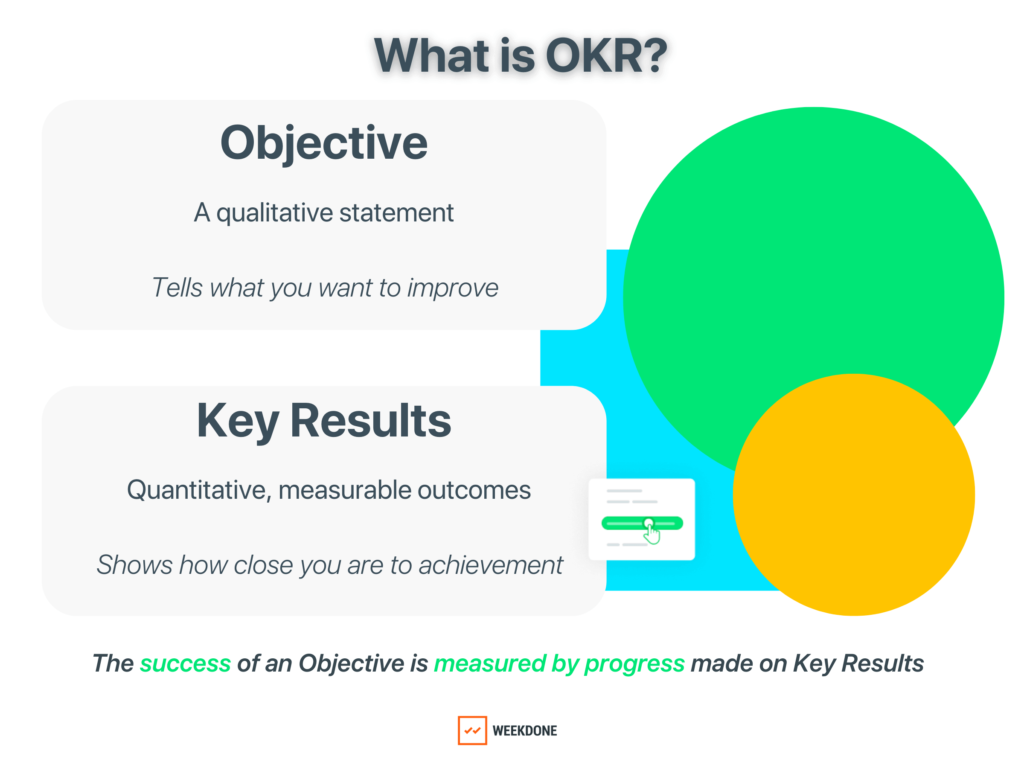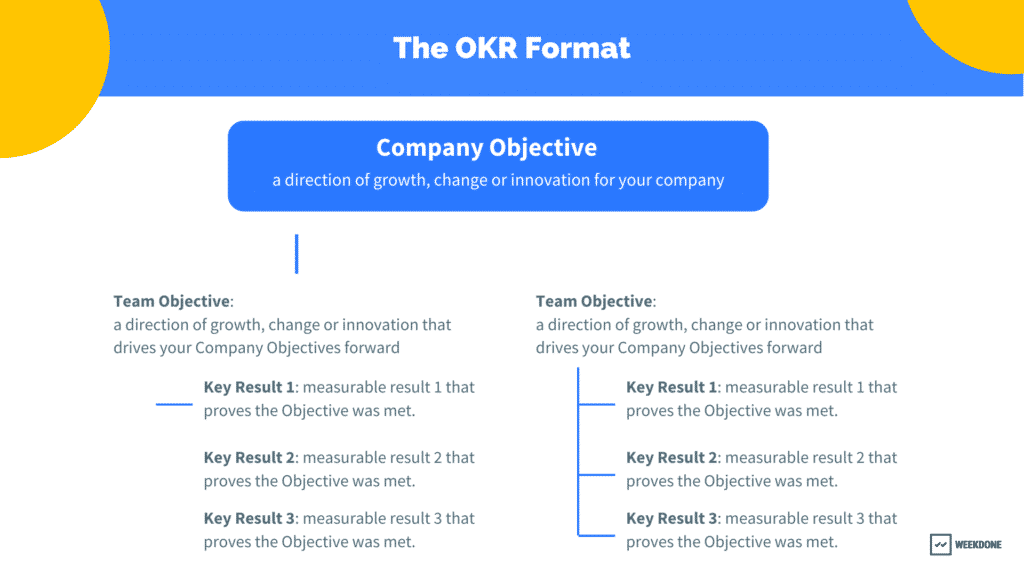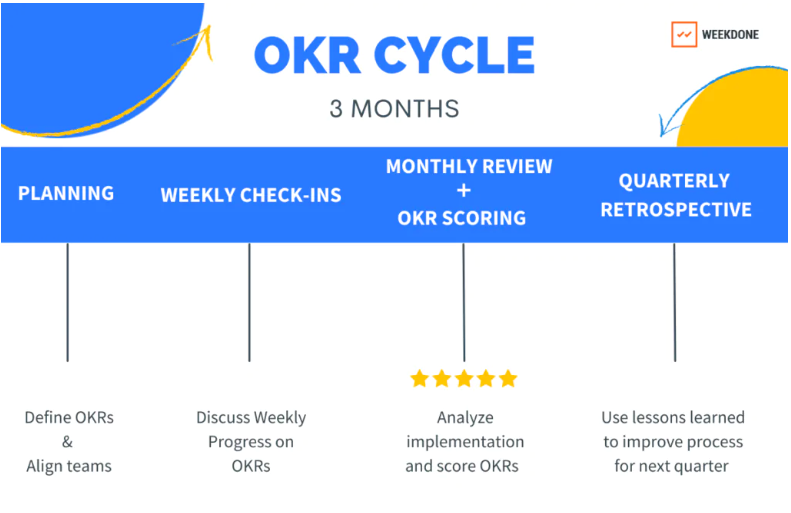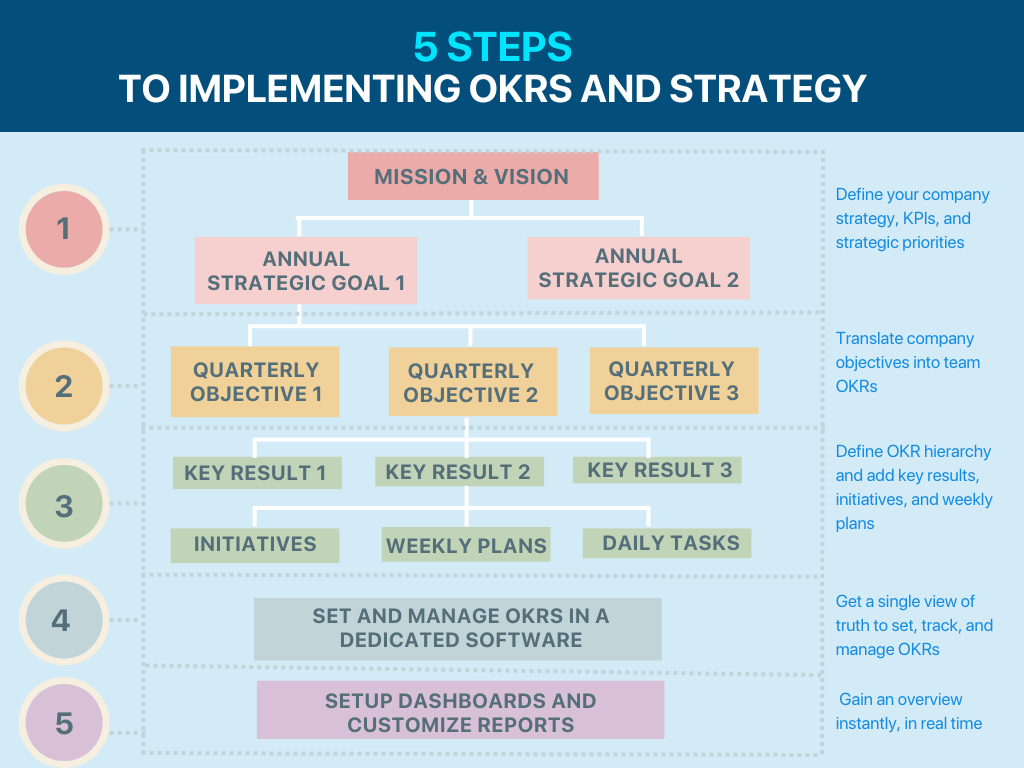OKRs (Objectives and Key Results) and FAST goals (Frequently Discussed, Ambitious, Specific, and Transparent) are two popular goal-setting approaches used to define and measure strategic objectives. Both methodologies can help companies achieve their desired outcomes and drive strategy execution.
While both frameworks have their advantages, understanding the differences between them can help you use them effectively. In this article, we will compare OKRs and FAST Goals to help you choose the best approach to ensure successful strategy execution.
What are OKRs
In the 1970s, Andy Grove, while the CEO of Intel, revamped the MBO framework and introduced OKRs. In 1999, John Doerr as an advisor introduced OKRs to Google and since then has helped many other tech companies grow and exceed expectations.
The OKR framework includes setting ambitious goals that are measurable and ambitious. The objectives define what needs to be improved and key results determine how high-priority goals will be attained and outcomes will be measured.
The essence of OKRs is to track progress made toward achieving Objectives and measure progress of Key Results to understand what needs to change or improve.
OKRs is to track progress made toward achieving Objectives and measure progress of Key Results to understand what needs to change or improve.
They keep teams motivated by providing a clear link between objectives and results and help focus on important improvements. This goal-setting framework revolves around measurable and achievable key results and ensures the team’s objectives are aligned with the company’s overall goals.

OKR FAQs
How Many OKRs should we set?
While this may depend on the size of your team, it is ideal to set 1-3 OKRs in a quarter for the whole company. Initially setting one OKR for the company in a quarter can enable teams to focus on one objective and associated key results. In this way, it can increase the chances of success.
💡 Wondering how many OKRs to create? Learn the best practices for setting OKRs

How long is an OKR cycle?
An OKR cycle is typically 3 months. If you are creating OKRs for the first time and are a small-to-medium company and need flexibility you can set OKRs for a shorter period. You can start with a 6 weeks cycle instead of quarterly OKRs.
💡 Annual vs Quarterly OKRs? Find out what works better

How long does it take to get started with OKRs?
Especially if you are just starting, OKR planning can take time. Therefore, it is advised to begin planning 2 to 4 weeks before the quarter begins.
Additionally, you need to keep time to conduct quarterly OKR retrospectives so that you can adjust your OKRs based on learnings
It typically takes 2 to 3 quarters to fine-tune your goal-setting process until you can observe impact and expect results.
💡 If you are in the early stages of OKR implementation, here are 3 strategies in this OKR implementation guide to help you better manage the OKR process over time.

📘 For more OKR FAQs, find answers to all your questions on this page
👉 What to know more about OKRs? Find out everything there is to know about OKRs.
Make goal-setting work in your business context.
What are FAST Goals
In 1954, Peter Drucker introduced FAST goals (Frequently Discussed, Ambitious, Specific, and Transparent) as a part of the MBO (Management By Objectives) framework. He created a structured goal-setting framework (typically set annually) to improve performance management.
FAST goals are designed to be transparent, allowing everyone in the organization to understand their role in achieving ambitious goals of the company. It provides a framework for setting ambitious yet achievable FAST goals that are transparently communicated across the company. The key principles of FAST Goals are:
1. Frequently Discussed
The FAST goals framework works when ongoing discussions are held to talk about goals of different stakeholders in the company – from managers, teams leaders, department heads, and other team members.
Having conversations to measure progress of FAST goals and their alignment with the vision, mission, and strategy of the company, can help companies stay agile and adapt easily to the changing business environment.
2. Ambitious
Setting FAST ambitious goals encourages higher performance and improves productivity. The framework creates a positive and healthy competitive environment wherein employees can share their achievements and exchange insights about improvements that need to be made.
3. Specific
Creating aspirational goals that are not specific and measurable can lead to setting unattainable and unrealistic goals. FAST goals that are transparent can help employees understand what needs to be done to drive objectives and achieve specific results.
4. Transparent
With an overview of the goals of different teams it becomes easier to understand if there is alignment and that everyone is working towards a shared goal. Setting transparent goals is important to identify gaps in corporate strategy execution and helps to realign goals to ensure teams are working cohesively.
Difference Between OKRs and FAST Goals
There are many overlapping aspects of both OKR and FAST goals frameworks. They require ambitious goals to be specific and measurable, and the goal-setting process to be structured and transparent. However, some of the key differences between OKRs and FAST goals include:
➖ Process of Continuous Improvement
The OKR cycle includes key aspects such as weekly check-ins and quarterly retrospectives. These milestones for continuous improvement are not included in the FAST goals framework. These ongoing discussions are important to maintain focus, instill accountability, and ensure agility.
➖ Structured Goal-Setting Cycle
OKR is a quarterly goal-setting framework. This gives four learning cycles in a year to allow teams to improve their results quarter on quarter. The FAST goals framework as a goal-setting approach can be applied for any period and does not have a specified time frame.
➖ Goal Alignment
To unify goals set across the organization, alignment is important. The OKR framework uses a bottom-up and top-down approach to link goals.
Instead of only focusing on a top-down approach of cascading FAST goals it ensures strategy and organizational objectives are articulated from the top management and team OKRs aligned to it are created by team members and department heads. This feedback loop ensures goals are aligned, relevant, and achievable.
👉 Explore how you can achieve goal alignment with these examples.
➖ Focus on Outcomes not Output
One of the key aspects of FAST Goals is creating measurable and ambitious goals. OKRs take this a step further by ensuring objectives are accompanied by specific key results – which are measurable outcomes.
The difference is the focus on outcomes rather than outputs. It focuses less on deliverables and more on the results or impact of implementing those deliverables.
▶️ Watch this video to learn the key differences between Outputs and Outcomes.
Combining 2 approaches: OKRs and FAST goals
When the OKR and FAST Goals frameworks are combined, they can deliver optimal results by establishing an ambitious goal-setting process – one that is measurable and promotes continuous improvement. Moreover, they can align the goals of your teams with the overarching vision, mission, and strategy of the company.
Combining the FAST goals framework and OKRs can help you build high-performing teams and create a work environment of continuous improvement where everyone works toward consistently exceeding expectations. A structured goal-setting process and team alignment could be the perfect formula that your company may need to be adaptable, agile, and ambitious in a demanding business environment that is constantly changing.
Whether you choose to combine OKRs and FAST goals or adopt another approach (such as SMART goals) to create goals; an efficient way to set, track, and measure your goals is by using a dedicated OKR software.
Find out how you can elevate your goal-setting process and successfully translate your strategy into action.